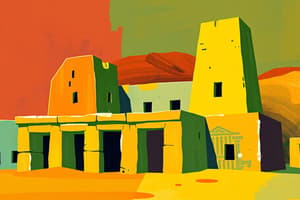Podcast
Questions and Answers
What is the oldest known representational image-making?
What is the oldest known representational image-making?
- A drawing of a lion in the cave at Lascaux
- A 2.4-inch tall female figure carved out of mammoth ivory (correct)
- A sculpture of a mammoth in the Aurignacian culture
- A painting of a horse in the cave at Chauvet-Pont-d'Arc
What is the age of the charcoal used to depict the two head-to-head rhinoceroses in the cave at Chauvet-Pont-d'Arc?
What is the age of the charcoal used to depict the two head-to-head rhinoceroses in the cave at Chauvet-Pont-d'Arc?
- Between 15,000 and 25,000 years ago
- Over 82,000 years ago
- Between 30,340 and 32,410 years ago (correct)
- Over 35,000 years ago
What is the significance of the overlapping horses in the cave at Chauvet-Pont-d'Arc?
What is the significance of the overlapping horses in the cave at Chauvet-Pont-d'Arc?
- They represent different types of horses
- They depict a herd of horses
- They show the evolution of horse drawings over time
- They potentially represent the same horse over time (correct)
What is the age of the paintings in the cave at Lascaux and Altamira?
What is the age of the paintings in the cave at Lascaux and Altamira?
What is depicted in the drawings of the cave at Chauvet-Pont-d'Arc?
What is depicted in the drawings of the cave at Chauvet-Pont-d'Arc?
What is the age of the drawings in the cave at Pech Merle?
What is the age of the drawings in the cave at Pech Merle?
What is the difficulty in understanding the original meanings of the paintings in the caves?
What is the difficulty in understanding the original meanings of the paintings in the caves?
Flashcards are hidden until you start studying
Study Notes
The Origins of Art: Paleolithic Cave Paintings
- Humans have been making art for a long time, using whatever technology is available.
- Non-representational ornamentation has been found across Africa, dating back over 82,000 years.
- The oldest known representational imagery comes from the Aurignacian culture of the Upper Paleolithic period, with over 200 caves across Europe containing paintings, drawings, and sculptures.
- The oldest undisputed example of representational image-making is a 2.4-inch tall female figure carved out of mammoth ivory, dating back to 35,000 BCE.
- The caves at Chauvet-Pont-d'Arc, Lascaux, Pech Merle, and Altamira contain the best-known examples of prehistoric painting and drawing, with remarkably evocative renderings of animals and humans.
- The paintings in the cave at Chauvet-Pont-d'Arc are believed to be over 30,000 years old, while those at Lascaux and Altamira date to approximately 15,000 BCE, and those at Pech Merle date to both 25,000 and 15,000 BCE.
- Understanding the creators and original meanings of these paintings is difficult, especially since Paleolithic humans did not have the same cultures or linguistic structures as modern humans.
- The cave at Chauvet-Pont-d'Arc is over 1,000 feet in length with two large chambers, and its drawings depict large animals including horses, mammoths, musk ox, ibex, reindeer, aurochs, megaceros deer, panther, and owl.
- The charcoal used to depict the two head-to-head rhinoceroses in the cave at Chauvet-Pont-d'Arc has been dated to between 30,340 and 32,410 years ago.
- The drawings in the cave at Chauvet-Pont-d'Arc may be more sophisticated than previously thought, with overlapping horses potentially representing the same horse over time.
- The cave at Chauvet-Pont-d'Arc also contains drawings of a woman's thighs and genitals, a bison, and a lion, which are nearly intertwined, cautioning against ready assumptions.
- The cave at Chauvet-Pont-d'Arc is also littered with the skulls and bones of cave bear and the track of a wolf, as well as a foot print thought to have been made by an eight-year-old boy.
Studying That Suits You
Use AI to generate personalized quizzes and flashcards to suit your learning preferences.




